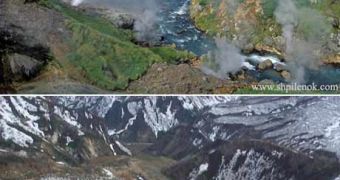A geyser is a type of hot spring that erupts periodically, ejecting a column of hot water and Steam into the air. Their emergence needs a combination of factors (water, heat and fortuitous plumbing) that exists in only a few places on Earth, and so they are fairly rare phenomena.
There are about 1,000 worldwide and approximatively 50 % of them being located in the Yellowstone National Park, U.S. Now the world's second geyser field, Dolina Geiserov ("Valley of Geysers"), in Kamchatka Peninsula (Russia) has literally disappeared in a minute.
This is the only place on continental Eurasia where geysers are found.
The famous valley, part of the Kronotsky Nature Preserve, was buried on June 3 after an entire mountainside collapsed, announced the conservation nonprofit World Wildlife Fund (WWF).
Geyser River, which once ran freely through the unique vale filled with millions of gallons of rock, gravel, snow and ice.
Beside Yellowstone National Park and Dolina Geiserove, other places on Earth where geysers are found are Iceland, Chile, and New Zealand and even in California, Peru, Bolivia, Dominica, Azores, Kenya and Japan.
In Kamchatka geyser field there are over 20 big jets and 200 smaller thermal springs in a 2.7-square-mi (7-square-km) area.
"We've lost one of the great natural wonders of the world," said Laura Williams, director of WWF Russia's Kamchatka office. "The landslide was likely caused by an earthquake, as Kamchatka is located on the tectonically unstable "Ring of Fire" circling the Pacific Ocean," said Margaret Williams of WWF's Alaska office.
Much of the peninsula, including the unique Valley of the Geysers, has been designated a UNESCO World Heritage Site due to the presence of almost a hundred volcanoes.
If the new river blockage is not broken, the valley could turn into a large heated lake. This would eliminate from the area many local species. Salmons will lose a spawning area and their predators like bears and sea eagles, will be affected.
Tourists of the uninhabited valley were lucky: a group of 19 barely escaped alive from the disaster, as the debris stopped less than 3 ft (1 m) from their helicopter and the buildings they were housed.

 14 DAY TRIAL //
14 DAY TRIAL //